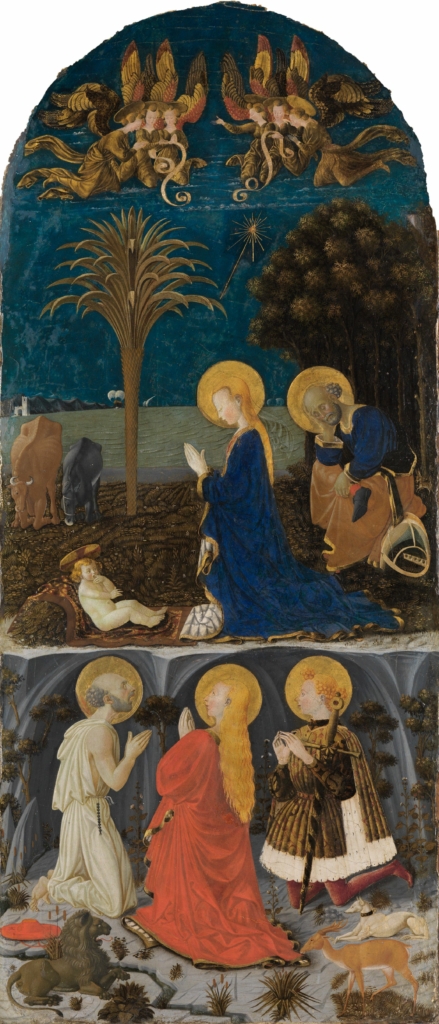
| X (Twitter) | |
|---|---|
URL kopieren
Die URL wurde erfolgreich kopiert und befindet sich in der Zwischenablage |
|
Im Zuge des Website-Relaunchs finden Sie hier vorerst keine hochauflösenden Abbildungen. Im Hintergrund arbeiten wir daran, sie Ihnen an dieser Stelle schnellstmöglich präsentieren zu können. Bis dahin wenden Sie sich gerne per Mail an digital@kunsthalle-karlsruhe.de, wenn Sie Abbildungen in hoher Auflösung benötigen.
Adoration of the Christ Child with Saint Jerome, Saint Mary Magdalene, and Saint Eustace
Paolo Uccello
H 48.5cm W 111cm
around 1436
KunsthalleKarlsruhe@ZKM
Description
Here, two adoration scenes are combined unusually, one above the other. The work is attributed to Paolo Uccello, one of the great masters of the early Italian Renaissance. Typical for this period is the tentative approach to reality utilising various pictorial means. For example, the clear structure of the seascape, which gradually stretches towards the horizon, the almost mathematical stylisation of the palm tree, or the attempt to create corporeality in the doll-like figures, for example, through drapery.
Who Is Who
0:00
0:00
If you look for documents about this painting in the Kunsthalle Karlsruhe, you won’t find anything under the letter U for Uccello. The reason for this is that the story of the painting is actually the story of an intensive search for a name, which has only just come to an end.
The Name Game
Matteo de’ Pasti, Florentine, in the manner of Alesso Baldovinetti and Benedetto Buonfigli — these are just some of the names that are found in catalogues or inventories in reference to this painting.
Under Investigation
What to do with an unsigned painting, about which one has hardly any reliable facts like a date or place of origin? Attributions and non-attributions, such as those in the case of this nocturnal adoration scene, are rather like a trial based on circumstantial evidence. One compares, checks the hand of the suspected creators, searches for similar compositions, motifs, painting techniques, and so on. For example, on the predella of an altarpiece in Quarate, a small place not far from Florence, one finds a mirrored version of Joseph, lost in thought, who in our painting is sitting behind Mary and the Christ Child. The colours, three-dimensional representation of figures and plants, and the design of the space through perspective all point to Florence during the second third of the 15th century.
The First Clue
Soon after the painting arrived in the collection of the Kunsthalle in 1857, it was suggested that Paolo Uccello was the author of the unusual composition, constructed as though in layers. In the 1930s, people became more cautious again: it was still suspected that the artist came from Uccello’s studio, but in the absence of reliable facts the author was simply named the Master of the Karlsruhe Adoration and the work was made the nucleus of a group where all the paintings were given the same artist’s name.
In the meantime, research tends to equate this provisionally named Master with Paolo Uccello, a highly influential master painter of the early Renaissance.
The Clue Is in the Name
However, it’s worth taking a closer look the name itself: the painter’s name was actually Paolo di Dono. “Uccello” was just a nickname he was given because he was passionate about depicting animals, especially birds — uccello means bird in Italian. The animals in the Karlsruhe painting are not only possible clues to the artist’s identity or just a charming feature, they are also clues to the identity of the saints depicted: a lion accompanies Saint Jerome, and a stag and a dog Saint Eustace. The names of the saints, in turn, could be clues to the origin of the panel: Does it come from a church dedicated to one of these saints?
The search goes on…
Dates and facts
| Title | Adoration of the Christ Child with Saint Jerome, Saint Mary Magdalene, and Saint Eustace |
|---|---|
| Artist | Paolo Uccello |
| Date | around 1436 |
| Measurements Painting | H 111cm W 48.5cm |
| Material | Poplarwood |